817 Search Results for praactical teaching
September 3, 2015
by Carole Zangari -

Looking for information to help you round out your services to beginning communicators? Here are some previous posts to explore. Intervention Core Words, Direct Vocabulary Instruction, and Beginning Communicators Helping Beginning Communicators Expand Their Sentence Length Let Me Tell You Something: Narratives for the Beginning Communicator Breaking Through with Emerging Intentional and Beginning Communicators of All Ages A PrAACtical Literacy Activity for Beginning Communicators Ideas About Vocabulary Instruction for Beginning Communicators Videos Recommended Practices for Beginning Communicators Teaching Prelinguistic Communication to Beginning Communicators Using Symbols with Beginning Communicators Other 5 Facebook Groups for Families of Beginning Communicators
August 18, 2015
by Carole Zangari -

Classrooms are busy places, and sometimes the AAC gets lost in the hustle and bustle. If you’re interested in boosting AAC use during the school day, here are some things to try. Co-teach or teach a lesson: Think it’s easy to model AAC and elicit it at the same time you’re providing whole class or small group instruction? Try it. Better yet, make teaching a co-teaching a lesson in the classroom part of your regular service delivery schedule. It’s scary at first, but hang in there. You’ll gain valuable information about what it takes to make AAC successful under real-world conditions, and gain credibility with the rest of the team. Offer support: “What can I do to make it easier for classroom staff to implement the AAC strategies?” “Ms. Aide, how can I help you use the device more when you talk to Shayna?” Make the data available to everyone... [Read More...]
August 10, 2015
by Carole Zangari -

The power of core vocabulary is only realized when AAC is being utilized throughout the day. A key benefit of having core words on an AAC system is that they apply to any situation, in any location, with any communication partners. But unless we’re actually teaching and using the AAC under those conditions, we haven’t really tapped into the power that they offer. It would be like upgrading to a powerful ‘gamer’ laptop, then just using it to check email. Core vocabulary is a powerful concept, but it only becomes a powerful tool when it gets used throughout the day by anyone who speaks to the learner. It may take some time to get there, but it’s critical that we keep striving for this. Otherwise, we’re checking email on a super-charged computer. While powerful, core words can’t do everything. AAC learners also need words that reflect their own lives and... [Read More...]
August 6, 2015
by Carole Zangari -
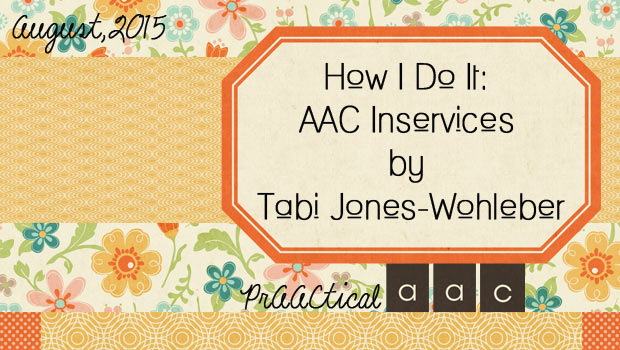
Many SLPs involved in AAC service provision are called upon to provide inservice training on implementation strategies. In this post, we are very fortunate to have Tabi Jones-Wohleber back to share both her thoughts and training materials. Tabi, an SLP on the AT Team for Frederick County Public Schools in Maryland, wrote two previous posts for us. In those posts, Tabi shared her All-in-One Visual Support Tool and Classroom CORE Tool. Today, we hear about her experiences with professional development for teachers, aides, and therapists who serve students with AAC needs. ::::::::::::::::::::::::::::::::::::::::::::::::::::::::: Implementing AAC: A Picture…AND…A Purpose As I work with staff and students to support implementation of AAC, I’ve learned 2 important things about making it work: 1) Folks need to know what it looks like “in their classroom/life” AND 2) effective implementation does not emerge from directives, but rather evolves from understanding, engagement and ownership of the WHAT... [Read More...]
August 5, 2015
by Carole Zangari -
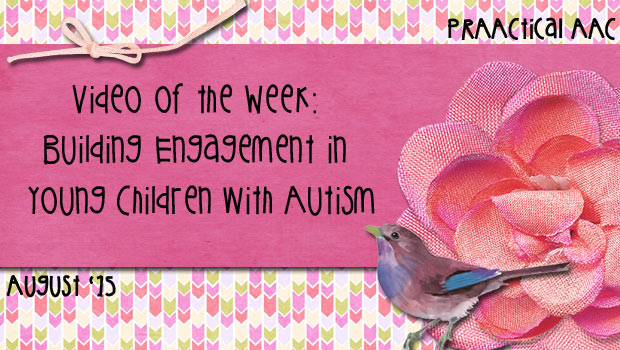
No matter what we are teaching, we won’t get very far unless we can help the learner engage. TASN addresses that very topic in today’s video. You can get the handout for this presentation here. Direct Link to Video: http://connect.enetcolorado.org/p8c8ijffpdl/
July 20, 2015
by Carole Zangari -
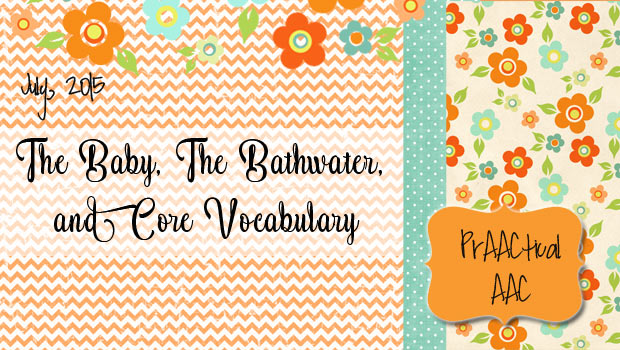
When we first started writing to advocate for core vocabulary, it was as a counterpoint to the noun-heavy, activity-specific AAC supports that were widely used among beginning communicators. Many times, those communication aids were great for getting communication started with our beginning communicators, but limited their ability for generative language development. Adding core vocabulary provided a lot of linguistic power, and for many learners, that’s a great thing. These days, most clinicians serving people with AAC needs are well aware of the need to populate their AAC systems with a sizable array of high-frequency core words. SLPs have, by and large, gotten the message that core vocabulary plays an important role for AAC learners. In some cases, though, the pendulum has swung a bit too far. An AAC a system built exclusively of single words with only core vocabulary is not likely to meet the needs of most AAC learners.... [Read More...]
July 9, 2015
by Carole Zangari -
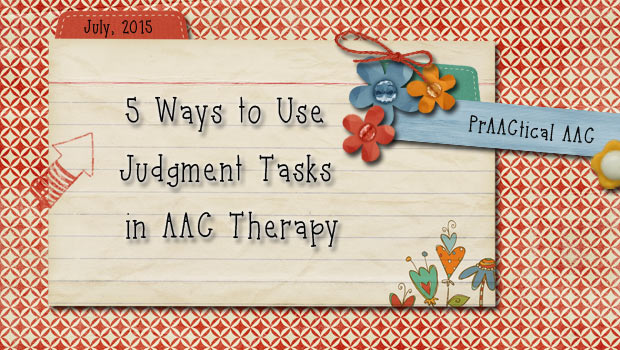
Judgment tasks refer to situations in which we present some examples and have the learner pass judgment on them. They can be examples of words used correctly/incorrectly, word endings used properly/improperly, or responses that fit well/poorly with a situation. We can set them up so that the learner weighs in with a binary judgment (e.g. thumbs up/down), gives them points (e.g., 2 points=perfect, 1=good, 0=wrong), a letter grade (e.g., A+ to F), or rates on a scale (e.g.,Excellent Okay Terrible). There are several reasons why I love judgment tasks. It can be a fun, low-stress way to increase their awareness of specific linguistic concepts. Think of it as giving them receptive exposure to the concept. In these tasks, we’re highlighting the concept but not expecting them to produce it. They put the learner in a position of power. Our prAACtical friends often don’t get enough experiences with that role, so... [Read More...]
June 15, 2015
by Carole Zangari -

Although summer is just beginning, many SLPs in our region are already thinking about the next school year. If you are trying to increase classroom use of AAC, you will want to check out the core vocabulary resources developed by Tabi Jones-Wohleber. Tabi is a Maryland-based SLP who works on the Frederick County Public Schools AT Team. You can view her earlier post (and accompanying downloads) here. In this post, Tabi shares her wonderful Communication Opportunities Ready to Engineer (CORE) book and explains how she uses these materials. ::::::::::::::::::::::::::::::::::::::::::::::::::::::::::::::::::::::::::::::::: Classroom CORE (Communication Opportunities Ready to Engineer) Book: When posed with the question “How can I use core more?” by a group of teachers inspired to make communication a priority, I was thrilled to be part of a team motivated to investigate this exciting question. These talented Rock Creek School educators teach a diverse population of students with all manner of physical,... [Read More...]
June 2, 2015
by Carole Zangari -
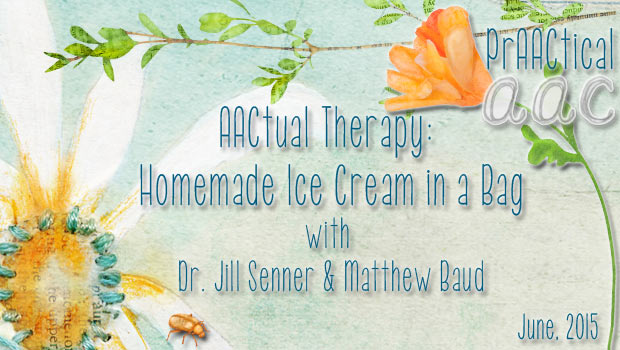
Jill Senner and Matthew Baud are back to share some of their favorite therapy activities. In this post, they discuss how they build language while making ice cream. Summer is almost here and we’re already thinking about making our favorite frozen treat, ice cream in a bag. No special equipment is required. With a couple of plastic zipper bags and 5 ingredients already in your kitchen, kids can shake milk into ice cream in just 5 minutes. Free picture recipes can be downloaded here. As with many of the cooking activities we love, there are lots of natural opportunities for language use before, during and after cooking. Before cooking we read the recipe and check the kitchen to see if we have the ingredients. If any are missing, we write shopping lists of ingredients we need. We can take a community field trip to the grocery store where there... [Read More...]
May 21, 2015
by Carole Zangari -

Better Hearing and Speech Month continues with guest blogger Tina Moreno. In this post, Tina shares some thoughts on building meaningful conversations in the classroom. She also made her visual support materials available for downloading (link at the end of her post). You can read Tina’s previous post for BHSM here. CONVERSATIONS IN THE CLASSROOM Fostering opportunities for meaningful conversation is critical throughout the school setting. Great discussions can happen in the classroom, but it can prove challenging for students to remain on topic, take conversational turns and give their peers wait time. In order to help students acquire these skills, we need to provide direct instruction, modeling by adults (and typically developing peers whenever possible!) and visual supports. Aim for the conversation target It can be difficult for students to keep track of the conversation target, especially in large group, fast-paced settings. It can be especially challenging for... [Read More...]









